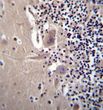beta Crystallin A3 (CRYBA1) (Center) Rabbit Polyclonal Antibody
CAT#: AP51091PU-N
beta Crystallin A3 (CRYBA1) (Center) rabbit polyclonal antibody, Aff - Purified
Other products for "beta Crystallin A3"
Specifications
| Product Data | |
| Applications | IHC, WB |
| Recommended Dilution | ELISA: 1/1000 Western blot: 1/100-1/500. Immunohistochemistry on Paraffin Sections: 1/10-1/50. |
| Reactivities | Human, Mouse |
| Host | Rabbit |
| Isotype | Ig |
| Clonality | Polyclonal |
| Immunogen | KLH conjugated synthetic peptide between 111-141 amino acids from the Central region of Human CRYBA1. |
| Specificity | This antibody recognizes Human and Mouse Beta-crystallin A3. |
| Formulation | PBS State: Aff - Purified State: Liquid purified Ig fraction Preservative: 0.09% Sodium Azide |
| Concentration | lot specific |
| Purification | Affinity Chromatography on Protein A |
| Conjugation | Unconjugated |
| Storage | Store undiluted at 2-8°C for one month or (in aliquots) at -20°C for longer. |
| Stability | Shelf life: one year from despatch. |
| Gene Name | crystallin beta A1 |
| Database Link | |
| Background | Crystallins are separated into two classes: taxon-specific, or enzyme, and ubiquitous. The latter class constitutes the major proteins of vertebrate eye lens and maintains the transparency and refractive index of the lens. Since lens central fiber cells lose their nuclei during development, these crystallins are made and then retained throughout life, making them extremely stable proteins. Mammalian lens crystallins are divided into alpha, beta, and gamma families; beta and gamma crystallins are also considered as a superfamily. Alpha and beta families are further divided into acidic and basic groups. Seven protein regions exist in crystallins: four homologous motifs, a connecting peptide, and N- and C-terminal extensions. Beta-crystallins, the most heterogeneous, differ by the presence of the C-terminal extension (present in the basic group, none in the acidic group). Beta-crystallins form aggregates of different sizes and are able to self-associate to form dimers or to form heterodimers with other beta-crystallins. This gene, a beta acidic group member, encodes two proteins (crystallin, beta A3 and crystallin, beta A1) from a single mRNA, the latter protein is 17 aa shorter than crystallin, beta A3 and is generated by use of an alternate translation initiation site. Deletion of exons 3 and 4 causes the autosomal dominant disease 'zonular cataract with sutural opacities' |
| Synonyms | CRYBA1, CRYB1 |
| Note | Molecular Weight: 25150 Da |
| Reference Data | |
Documents
| Product Manuals |
| FAQs |
| SDS |
{0} Product Review(s)
0 Product Review(s)
Submit review
Be the first one to submit a review
Product Citations
*Delivery time may vary from web posted schedule. Occasional delays may occur due to unforeseen
complexities in the preparation of your product. International customers may expect an additional 1-2 weeks
in shipping.






























































































































































































































































 Germany
Germany
 Japan
Japan
 United Kingdom
United Kingdom
 China
China





